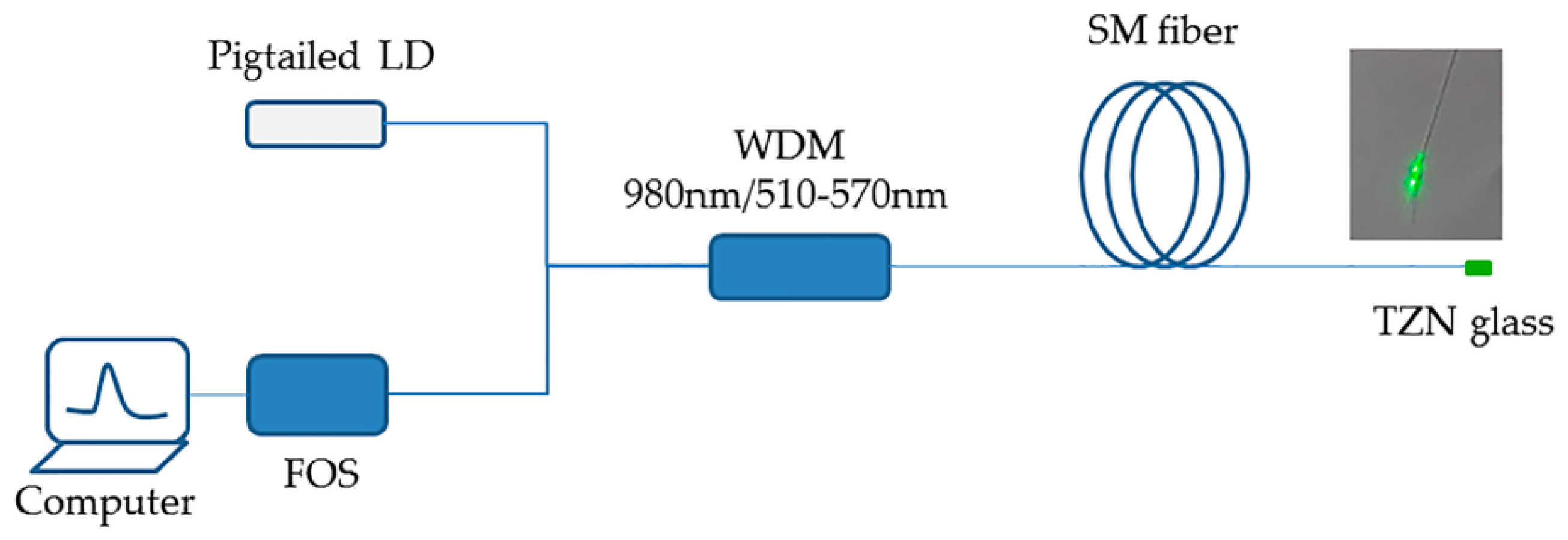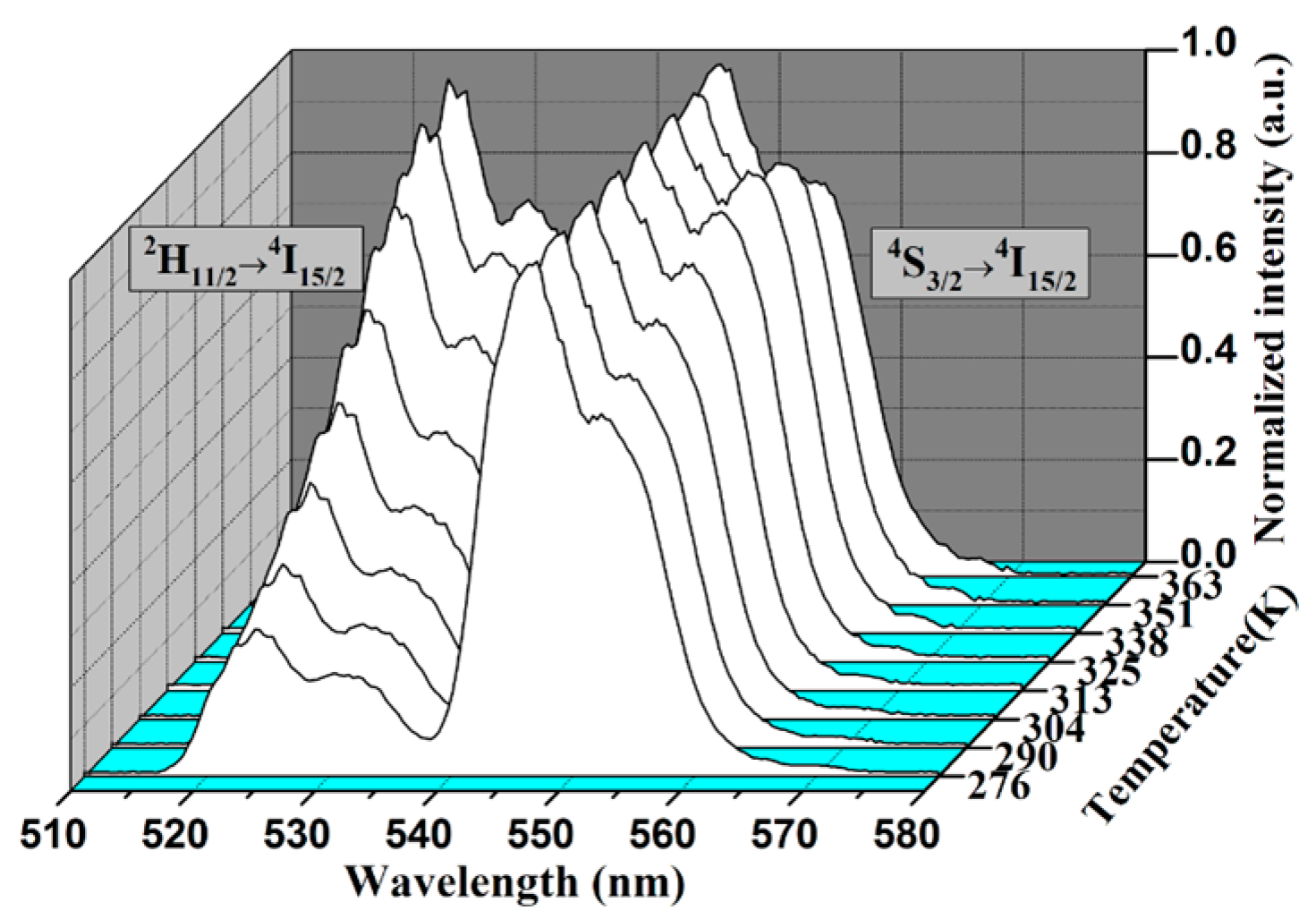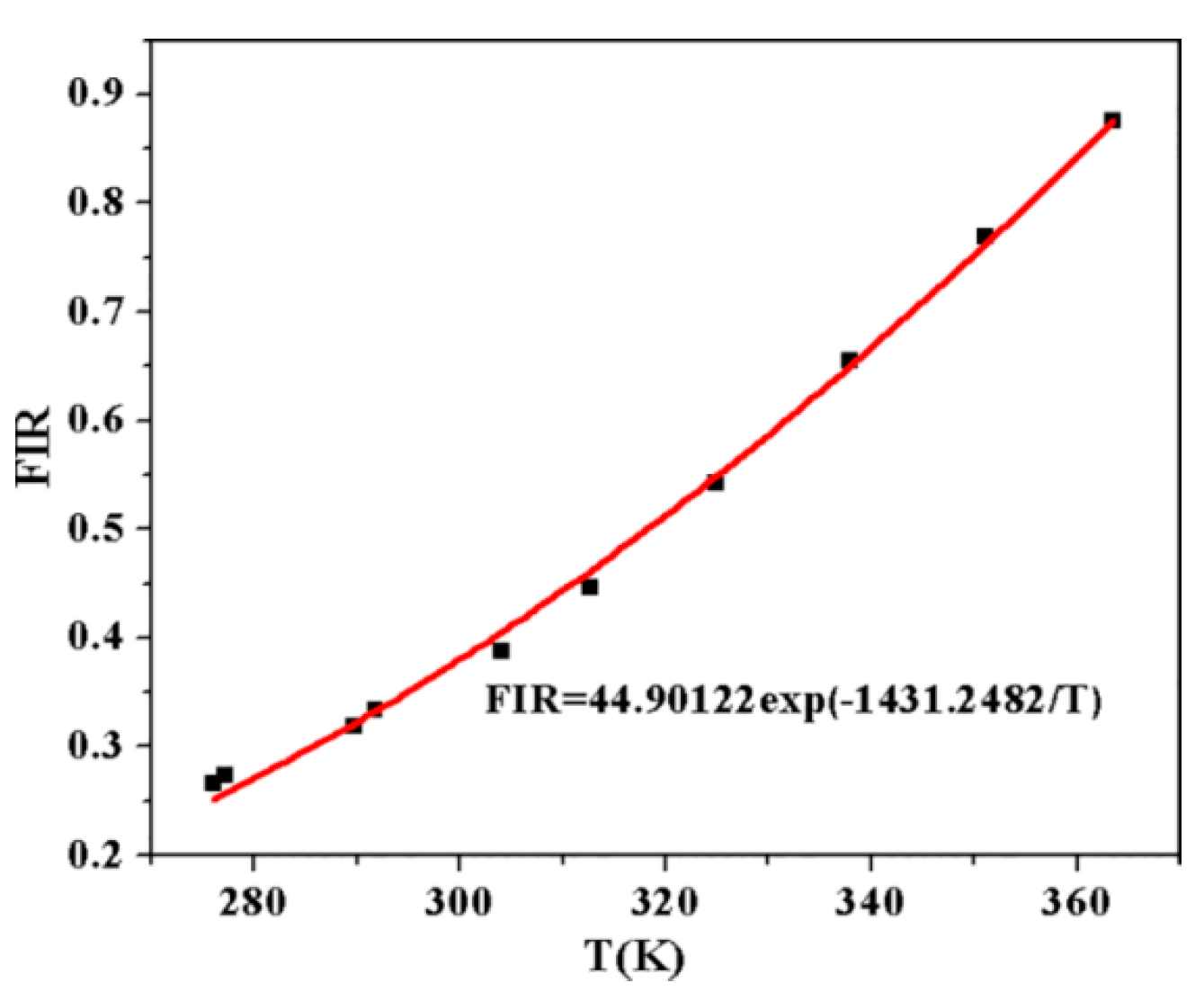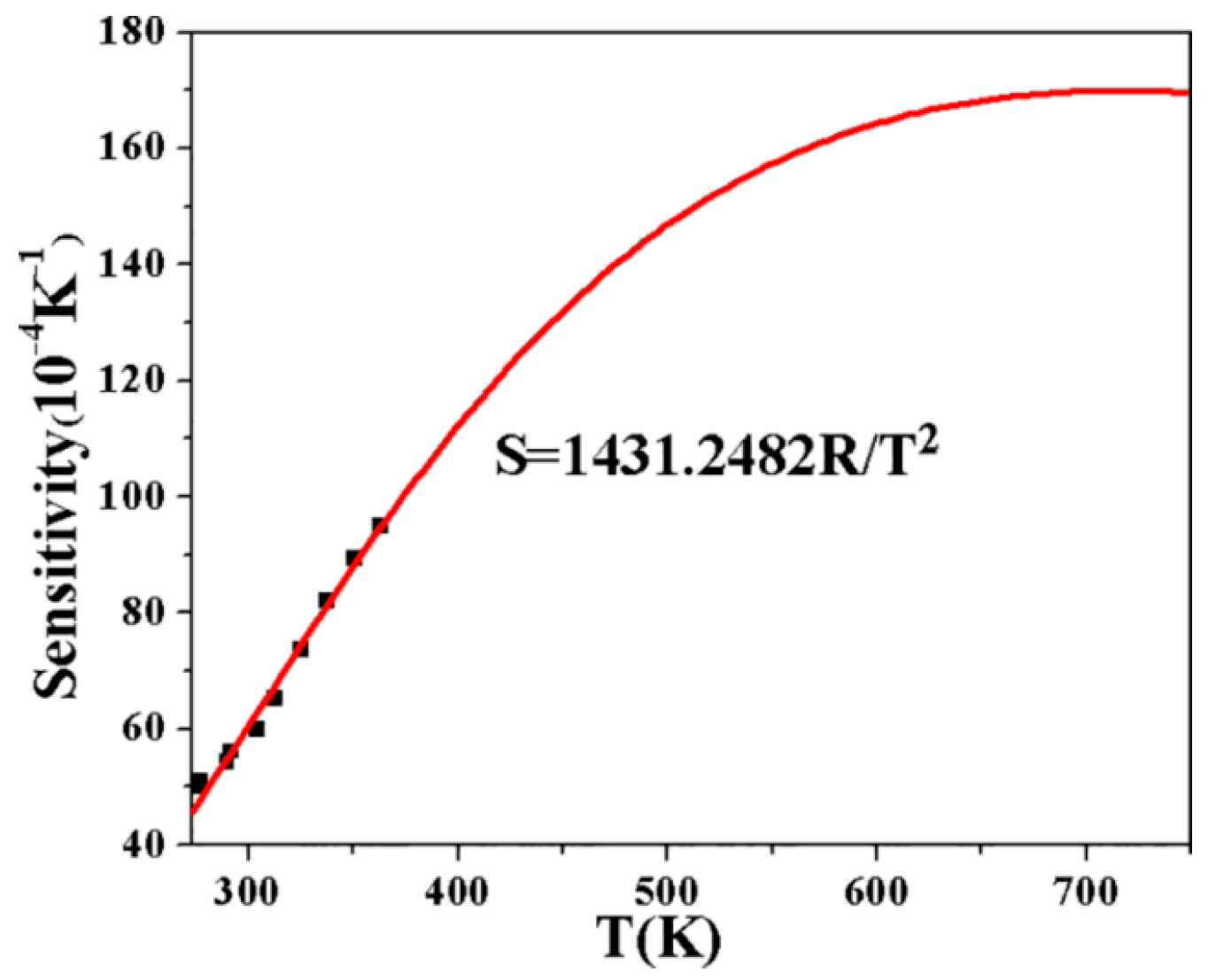A Point Temperature Sensor Based on Upconversion Emission in Er3+/Yb3+ Codoped Tellurite-Zinc-Niobium Glass
Abstract
:1. Introduction
2. Experimental Section
3. Results and Discussion
4. Conclusions
Acknowledgments
Author Contributions
Conflicts of Interest
References
- Allwood, G.; Wild, G.; Hinckley, S. Optical fiber sensors in physical intrusion detection systems: A review. IEEE Sens. J. 2016, 16, 5497–5509. [Google Scholar] [CrossRef]
- Gorriz, B.T.; Paya-Zaforteza, I.; Calderon-Garcia, P.A.; Maicas, S.S. New fiber optical sensor for monitoring temperatures in concrete structures during fires. Sens. Actuators A Phys. 2017, 254, 116–125. [Google Scholar] [CrossRef]
- Chen, D.; Liu, S.; Wan, Z.; Chen, Y. A highly sensitive upconverting nano-glass-ceramic-based optical thermometer. J. Alloy Compd. 2016, 672, 380–385. [Google Scholar] [CrossRef]
- Berthou, H.; Jörgensen, C.K. Optical-fiber temperature sensor based on upconversion-excited fluorescence. Opt. Lett. 1990, 15, 1100–1102. [Google Scholar] [CrossRef] [PubMed]
- Wojciech, A.P.; Joanna, P.; Radoslaw, L.; Witold, R.R. Er3+/Yb3+ co-doped lead germinate glasses for up-conversion luminescence temperature sensors. Sens. Actuators A Phys. 2016, 252, 54–58. [Google Scholar]
- Feng, Z.Q.; He, Y.Y.; Bai, H.X.; Cao, B.S. Green up-conversion emissions and optical thermometry of Er3+ doped borosilicate glass. Opt. Eng. 2011, 50, 049001. [Google Scholar]
- Qiao, X.; Fan, X.; Wang, M. Spectroscopic properties of Er3+ doped glass ceramics containing Sr2GdF7 nanocrystals. Appl. Phys. Lett. 2006, 89, 111919. [Google Scholar] [CrossRef]
- Zou, X.L.; Izumitani, T. Spectroscopic properties and mechanisms of excited state absorption and energy transfer upconversion for Er3+-doped glasses. J. Non-Cryst. Solids 1993, 162, 68–80. [Google Scholar] [CrossRef]
- Xue, Z.; Hou, Z.; Wang, S.; Hu, X.; Lu, H.; Niu, C.; Wang, H. Research progress of up-conversion tellurite glass. Ordn. Mater. Sci. Eng. 2010, 33, 92–96. [Google Scholar]
- Shen, X.; Nie, Q.; Xu, T.; Dai, S.; Wang, X. Temperature dependence of upconversion luminescence in erbium-doped tellurite glasses. J. Lum. 2010, 130, 1353–1356. [Google Scholar] [CrossRef]
- Leon-Lius, S.F.; Rodrriguez-Mendoza, U.R; Martin, I.R. Effects of Er3+ concentration on thermal sensitivity in optical temperature fluorotellurite glass sensors. Sens. Actuators B Chem. 2013, 176, 1167–1175. [Google Scholar] [CrossRef]
- Pandey, A.; Som, S.; Kumar, V.; Kumar, V.; Kumar, K.; Kumar Rai, V.; Swart, H.C. Enhanced upconversion and temperature sensing study of Er3+-Yb3+codoped tungsten-tellurite glass. Sens. Actuators B Chem. 2014, 202, 1305–1312. [Google Scholar] [CrossRef]
- Schartner, E.P.; Monro, T.M. Fiber tip sensors for localised temperature sensing based on rare earth-doped glass coatings. Sensors 2014, 14, 21693–21701. [Google Scholar] [CrossRef] [PubMed]
- Musolino, S.; Schartner, E.P.; Tsiminis, G.; Salem, A.; Monro, T.M.; Hutchinson, M.R. Portable optical fiber probe in vivo/brain temperature measurements. Biomed. Opt. Express 2016, 7, 3069–3078. [Google Scholar] [CrossRef] [PubMed]
- Zhao, S.; Zheng, F.; Xu, S.; Wang, H.; Wang, B. Er3+-doped phosphor-tellurite glass for broadband short-length Er3+-doped fiber amplifier. Chin. Opt. Lett. 2008, 6, 276–278. [Google Scholar] [CrossRef]
- Sabadel, J.C.; Armand, O.; Cachau-Herreillat, D. Structural and nonlinear optical characterization of tellurium oxide-based glasses: TeO2-BaO-TiO2. J. Solid State Chem. 1997, 132, 411–419. [Google Scholar] [CrossRef]
- Murugan, G.S.; Ohishi, Y. Raman spectroscopic studies of TeO2-BaO-SrO-Nb2O5 glasses: structure-property correlations. J. Appl. Phys. 2004, 96, 2437–2442. [Google Scholar] [CrossRef]
- Yang, Q.; Chen, D.; Qian, Q. Effect of Nb2O5/WO3 codoping on thermal stability and Raman spectral properties of tellurite glasses. J. Inorg. Chem. 2009, 24, 1049–1053. [Google Scholar]
- Wade, S.A.; Collins, S.F.; Baxter, G.W. Fluorescence intensity ratio technique for optical fiber point temperature sensing. J. Appl. Phys. 2003, 94, 4743–4756. [Google Scholar] [CrossRef]
- Dong, B.; Cao, B.S.; Feng, Z.Q.; Wang, X.J.; He, Y.Y. Optical temperature sensing through extraordinary enhancement of green up-conversion emissions for Er-Yb-Mo:Al2O3. Sens. Actuators B Chem. 2012, 165, 34–37. [Google Scholar] [CrossRef]
- Vijaya, N.; Babu, P.; Venkatramu, V.; Jayasankar, C.K.; Leon-Luis, S.F.; Rofriguez-Mendoza, U.R.; Martin, L.R.; Lavin, V. Optical characterization of Er3+-doped zinc fluorophosphates glasses for optical temperature sensors. Sens. Actuators B Chem. 2013, 186, 156–164. [Google Scholar] [CrossRef]
- Cao, B.S.; He, Y.Y.; Feng, Z.Q.; Li, Y.S.; Dong, B. Optical temperature sensing behavior of enhanced green upconversion emission from Er-Mo:Yb2Ti2O7 nanophosphor. Sens. Actuators B Chem. 2011, 159, 8–11. [Google Scholar] [CrossRef]
- Xu, W.; Zhang, Z.; Cao, W. Excellent optical thermometry based on short-wavelength upconversion emissions in Er3+/Yb3+ codoped CaWO4. Opt. Lett. 2012, 37, 4865–4867. [Google Scholar] [CrossRef] [PubMed]
- Zheng, K.; Song, W.; He, G.; Yuan, Z.; Qin, W. Five UV upconversion emissions of Er3+ for temperature sensing. Opt. Express 2015, 23, 7654–7658. [Google Scholar] [CrossRef] [PubMed]






| Physical Parameters | Refractive Index (at 632.8 nm) | Density (g/cm3) | Tg (K) | Tx (K) | ΔT (K) |
|---|---|---|---|---|---|
| Value | 2.0329 | 5.082 | 683 | 875 | 188 |
| Materials | Dopant | Excitation Power | Maximum Sensitivity (K‒1) | Temperature (K) | References |
|---|---|---|---|---|---|
| Lead germinate glass | Er-Yb | / | 70 × 10−4 | 550 | [5] |
| Fluorotellurite glass | Er | 5 W/mm2 | 79 × 10−4 | 541 | [11] |
| Tungsten–tellurite glass | Er-Yb | 108 mW | 28 × 10−4 | 690 | [12] |
| Tellurite glass | Er-Yb | 0.3 mW | 39 × 10−4 | / | [13] |
| Al2O3 | Er-Yb-Mo | 2 mW | 51 × 10−4 | 443 | [20] |
| Fluorophosphate glass | Er | / | 54 × 10−4 | 630 | [21] |
| Yb2TiO7 | Er-Mo | 5 mW | 74 × 10−4 | 340 | [22] |
| CaWO4 phosphor | Er-Yb | 150 mW | 73 × 10−4 | 518 | [23] |
| β-NaLuF4 | Er-Yb | / | 52 × 10−4 | 303 | [24] |
| TZNb glass | Er-Yb | 1 mW | 95 × 10−4 | 363 | This work |
© 2017 by the authors. Licensee MDPI, Basel, Switzerland. This article is an open access article distributed under the terms and conditions of the Creative Commons Attribution (CC BY) license (http://creativecommons.org/licenses/by/4.0/).
Share and Cite
Wu, T.; Tong, R.; Liao, L.; Huang, L.; Zhao, S.; Xu, S. A Point Temperature Sensor Based on Upconversion Emission in Er3+/Yb3+ Codoped Tellurite-Zinc-Niobium Glass. Sensors 2017, 17, 1253. https://doi.org/10.3390/s17061253
Wu T, Tong R, Liao L, Huang L, Zhao S, Xu S. A Point Temperature Sensor Based on Upconversion Emission in Er3+/Yb3+ Codoped Tellurite-Zinc-Niobium Glass. Sensors. 2017; 17(6):1253. https://doi.org/10.3390/s17061253
Chicago/Turabian StyleWu, Ting, Rui Tong, Liwen Liao, Lihui Huang, Shilong Zhao, and Shiqing Xu. 2017. "A Point Temperature Sensor Based on Upconversion Emission in Er3+/Yb3+ Codoped Tellurite-Zinc-Niobium Glass" Sensors 17, no. 6: 1253. https://doi.org/10.3390/s17061253




